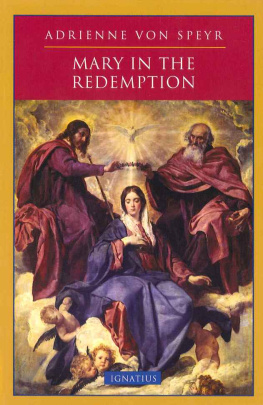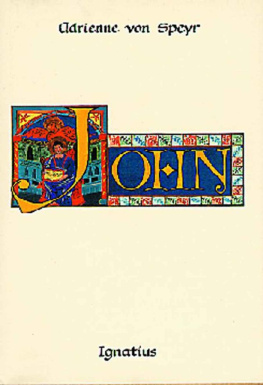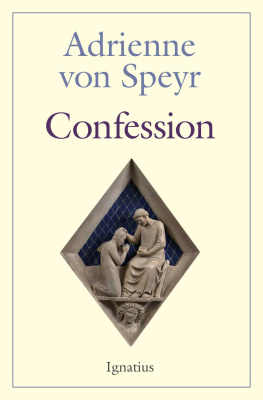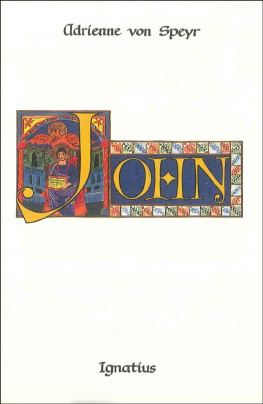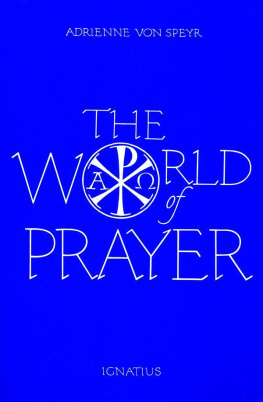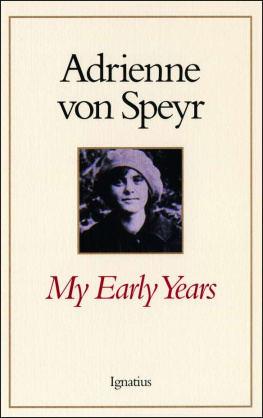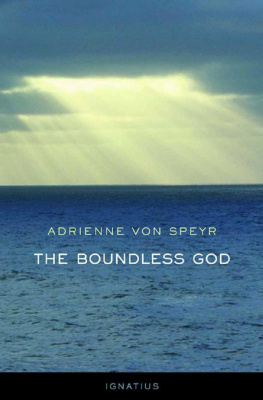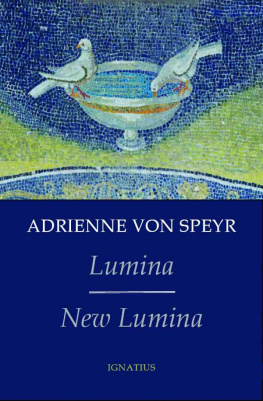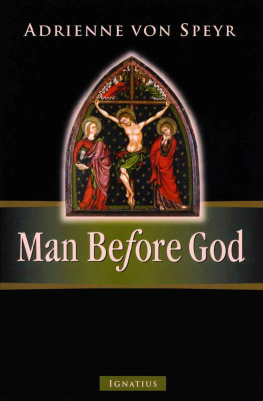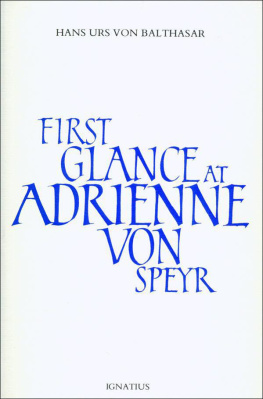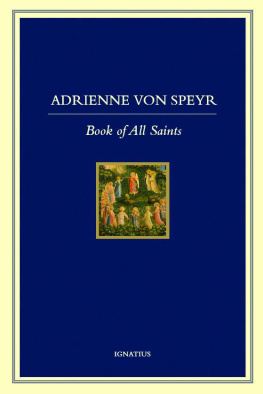Adrienne von Speyr - Mary in the Redemption
Here you can read online Adrienne von Speyr - Mary in the Redemption full text of the book (entire story) in english for free. Download pdf and epub, get meaning, cover and reviews about this ebook. year: 2003, publisher: Ignatius Press, genre: Religion. Description of the work, (preface) as well as reviews are available. Best literature library LitArk.com created for fans of good reading and offers a wide selection of genres:
Romance novel
Science fiction
Adventure
Detective
Science
History
Home and family
Prose
Art
Politics
Computer
Non-fiction
Religion
Business
Children
Humor
Choose a favorite category and find really read worthwhile books. Enjoy immersion in the world of imagination, feel the emotions of the characters or learn something new for yourself, make an fascinating discovery.
- Book:Mary in the Redemption
- Author:
- Publisher:Ignatius Press
- Genre:
- Year:2003
- Rating:3 / 5
- Favourites:Add to favourites
- Your mark:
- 60
- 1
- 2
- 3
- 4
- 5
Mary in the Redemption: summary, description and annotation
We offer to read an annotation, description, summary or preface (depends on what the author of the book "Mary in the Redemption" wrote himself). If you haven't found the necessary information about the book — write in the comments, we will try to find it.
Mary in the Redemption — read online for free the complete book (whole text) full work
Below is the text of the book, divided by pages. System saving the place of the last page read, allows you to conveniently read the book "Mary in the Redemption" online for free, without having to search again every time where you left off. Put a bookmark, and you can go to the page where you finished reading at any time.
Font size:
Interval:
Bookmark:
MARY IN THE REDEMPTION
ADRIENNE VON SPEYR
Redemption
TRANSLATED BY
HELENA M. TOMKO
IGNATIUS PRESS SAN FRANCISCO
Title of the German original:
Maria in der Erlsung
1979 Johannes Verlag, Einsiedeln
Translated from the third edition, 1999
Cover art: Diego Rodriguez de Silva y Velasquez
Coronation of the Virgin
Archivo Iconografico, S.A. / CORBIS
Cover design by Riz Boncan Marsella
2003 Ignatius Press, San Francisco
All rights reserved
ISBN 978-0-89870-955-1
Library of Congress control number 2002112864
Printed in the United States of America
Introduction
by Hans Urs von Balthasar
In contrast to the slim volume on our Lady, Handmaid of the Lord , the pieces presented here, for the most part written a decade later, probe the ultimate profundities of Mariology. Each piece forms a meditation in its own right, while the order in which the pieces have been placed originates with the editor. Yet they all revolve around the same mysterious center, identifiable in the words pre-redemption and co-redemption. The author does not allow superficial misgivings about these terms to impede her; she knows full well the infinite difference between the work of the God-Man and that of his Mother, who let things be done. (She always formulates her words with the utmost caution. If certain expressions appear ambiguous in their brevity, further explanations in other works will serve to clarify them. She will at times only allude to well-known things and presuppose those that are universally known.) She sees, however, the necessary unity between Mother and Sonbased in the orders of nature and graceand pursues this unity to its most hidden foundations: in the eternal salvific decree of the triune God and in the course of salvation history before and after Christs Incarnation. She sees all this without ever losing sight of the absolute concreteness of the relationship between mother and child, between this Mother and this Child, and the unique, wholly concrete personality of Mary. Fully aware of the indissoluble mystery that remains, as she stresses several times, she nonetheless surveys the mystery from all sides with an astonishing speculative power the like of which it is difficult to find in mariological literature. The meditations are so dense that readers have to feel their way from sentence to sentence without skipping a single one. Since the thoughts are always moving in the uncontained realm of the divine mystery of salvation, it can sometimes seem as if certain aspects are contradicting others. At a closer glance, the oppositions turn out to be perfectly reconcilable. They simply help to alleviate a false superficiality, the sense of having already attained sufficient understanding. One simply beholds the same center from opposite sides. With all the precision and subtlety of their thought, few writers today are able to arouse a sense of standing before the unfathomable greatness of God as well as Adrienne von Speyr.
Adriennes as yet unpublished diaries reveal the supremely personal contours of her relationship to Mary, with whom she could communicate with wonderful familiarity. This Intimacy forms the presupposed, but not thematized, background to the meditations presented here. This background can and should be felt in all that is said, since it would be foolish to identify all this as abstract.
What is presented here can help not only to revitalize Mariology in general, which these days has widely been put to one side, but more particularly to indicate paths, some of them new, along which Mariology can be taken up again and fruitfully pursued.
Hans Urs von Balthasar
Ecce ancilla. With these words Mary calls everyone into service. She is the chosen one, the one visited by the angel. Yet she would like to understand her service in such a way that, through her, it includes all the faithful. In giving the word, she hopes to do so in the name of all who are willing to believe. She is full of grace, but in answering in accordance with this grace, she would like to retreata mere handmaid!into the anonymity of serving. As the uniquely chosen one, she gives this anonymity to her service. Her willingness wants to include everything that God can in any way demand so that it might encompass the willingness of all women to accept the demands that have been made of her.
When A. saw this, she, too, understood perfectly well: Mary knows that it concerns the most intimate of all things and that her mystery will be one of the utmost personal fruitfulness. Her Yes contains something akin to a preview of its unending consequences. Nonetheless, by giving up herself, she says the word and accomplishes the act of willingness to serve in the name of the Church and of all who belong to the Communion of Saints. A. perceives a maternal gesture: how Mary gives herself up, as a woman, to the Holy Spirit so that he might overshadow her; how, in the same gesture, she passes on her gift of self to everyone else and opens it up to them.
She draws the line at nothing. The service she is ready and willing to undertake concerns the innermost as well as entirely external things. Part of her task, in obedience to the angel and out of concern for her child, will simply be to take her place at table alongside her relatives and friends. She does not distinguish between her new obedience to God and her perseverance in the obedience to which she was hitherto accustomed, just as she was hitherto completely familiar with the celestial world of the angels (so much so that the angel almost seemed like a friend to her) and yet, in simple faith, was awaiting neither a vision nor an angel. All boundaries have dissolved, and everything contributes to the unity of her service, in which she is the Mother of God and bride of Joseph, in which she makes no distinction between herself and other believers, and in which even the gates between heaven and earth have been torn down. The angel comes with his message from heaven. When she takes on his task as her own, she assumes heaven within herself in order then to make a gift of it to others on earth.
It is thus in two ways that she reveals heaven to those living on earth. All who contemplate her perceive that she has a piece of heaven within her; they also see that she bears the Son of God within her, and he again in his own way has heaven within him. These two heavens are of course one and the same. In this way, the obedience of the Son in his Incarnation together with the obedience of the Mother who said Yes to the angel become a single obedience. This obedience, which seems internally twofold and mutually dependent, is the starting point for any unity of obedience in God on the part of man. Obedience now looks like a movement that leads to unity. Thus the Sons obedience and the Mothers obedience harmonize in their shared and lasting gift of self to God the Father.
This is all contained in the ecce ancilla: service as resolve and accomplishment; of the Mother to and for the Son, who himself is resolved to serve the Father; a movement that remains eternally living. All subsequent accomplishments originate in the Yes accomplished at the start. The once-said Yes, the word of assent, guarantees that the Word will continue to remain living in the Mother. And forever, the most everyday and the most extraordinary share the same ground, because all boundaries have been removed. It is pointless to try to compartmentalize the Mother in some way or other, since she is indivisibly and forever a handmaid, and her whole being endeavors to meet the expectations of the divine Lord. The loftiest or the most meager thing can reside in each and every gesture that obedience demands of her, and yet she pays no attention to this. It is her genius to have described herself as handmaid and not as mother or bride or helpmate or daughter. In doing so, she embraces each and every form of service that is worthy of God. He can form from her everything that pleases him.
Next pageFont size:
Interval:
Bookmark:
Similar books «Mary in the Redemption»
Look at similar books to Mary in the Redemption. We have selected literature similar in name and meaning in the hope of providing readers with more options to find new, interesting, not yet read works.
Discussion, reviews of the book Mary in the Redemption and just readers' own opinions. Leave your comments, write what you think about the work, its meaning or the main characters. Specify what exactly you liked and what you didn't like, and why you think so.

